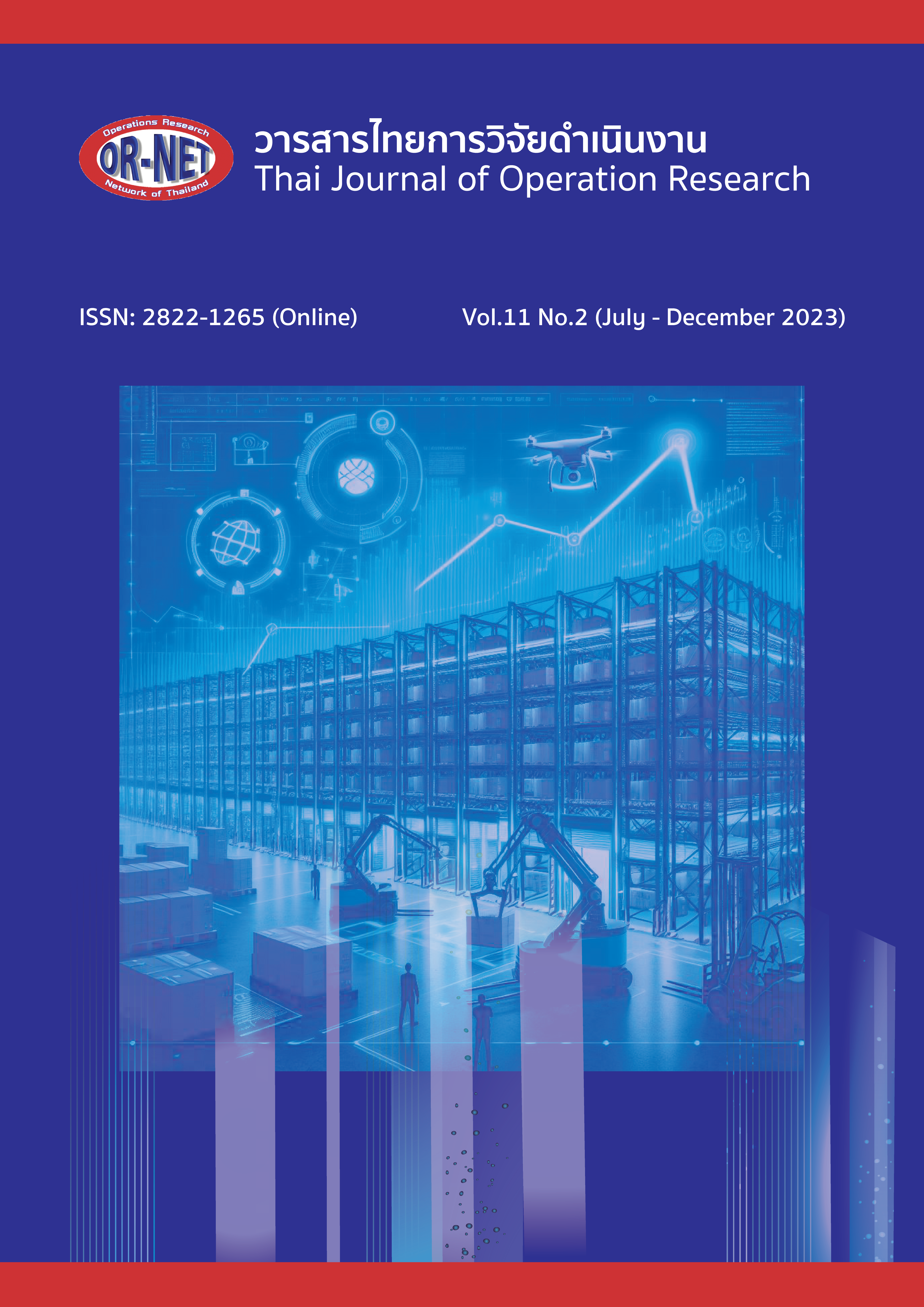A Comparison of the Efficiency of Data Mining Techniques to Create a Model for Forecasting the Use of Cosmetic Products Containing Aloe Vera for Small and Medium-Sized Community Enterprises in Prachuap Khiri Khan Province
Keywords:
Data mining, Classification, Aloe vera cosmeticsAbstract
The objectives of this study were to compare the efficiencies of the algorithms and feature selection methods used in data mining techniques in order to create the demand forecasting models for Aloe Vera cosmetic products. The data used in this study consisted of a total of 1,034 data sets. Feature selection was performed in order to select only key features by using CfsSubsetEval and InfoGainAttributeEval in combination with data classification and decision tree techniques. In this study, four techniques were used, including NaïveBayes, MultilayerPerceptron (MLP), J48 and REPTree. The results showed that the use of MLP neural network data mining technique in combination with InfoGainAttributeEval, a feature selection method, showed highest efficiency with an accuracy of 93.54%. The comparison of efficiencies showed that MLP technique can be used in forecasting and as a guide for niche marketing in order to provide advice on purchasing Aloe Vera cosmetic products to interested consumers for better access.
References
สินีนาถ เลิศไพรวัน สุมิตรา ศรีวิบูลย์ และ จันทร์จรัส
ศรีสิริ, “รายงานวิจัยโครงการศึกษาและพัฒนาบรรจุภัณฑ์เครื่องสําอางสมุนไพรเพื่อการส่งออก,” กรุงเทพฯ: มหาวิทยาลัยศรีนครินทรวิโรฒ, 2552.
ประกายดาว ศรีมุษิกโพธิ์, “การใช้วุ้นนว่านหางจระเข้รักษาแผลฉีกขาดและโรคผิวหนังชนิดขี้เรื้อนเปียกในสุนัข,” วารสารเกษตร., ปีที่ 22, ฉบับที่ 3, น. 245–252, 2549.
สมฤดี สังขาว, อทิตยา ขวัญวงส์, นงนุช ขอนทอง, เกศินี ใจดี, ณัฐฐินันท์ ชำรวย, อาภรณ์ พาชัย, มณฑา หมีไพรพฤกษ์ และ ณัฐภานี บัวดี, “ฤทธิ์การต้านอนุมูลอิสระปริมาณวิตามินซีและความพึงพอใจของสบู่ว่านหางจระเข้ผสมน้ำผึ้ง: สมุนไพรพญาไพร อำเภอเมือง จังหวัดกำแพงเพชร,” วารสารวิทยาศาสตร์และเทคโนโลยี(สทวท.)., ปีที่ 4, ฉบับที่ 1, น. 119-126, 2560.
M. A. Hall and G. Holmes, “Benchmarking attribute selection techniques for discrete class data mining,” IEEE Transactions on Knowledge and Data engineering., vol. 15, no. 6, pp. 1437-1447, 2003.
เสกสรรค์ วิลัยลักษณ์, วิภา เจริญภัณฑารักษ์ และ ดวงดาว วิชาดากุล, “การใช้เทคนิคการทำเหมืองข้อมูลเพื่อพยากรณ์ผลการเรียนของนักเรียนโรงเรียนสาธิตแห่งมหาวิทยาลัยเกษตรศาสตร์ วิทยาเขตกำแพงแสน ศูนย์วิจัยและพัฒนาการศึกษา,” วารสาร Veridian E Journal ฯ สาขาวิทยาศาสตร์และเทคโนโลยี., ปีที่ 2, ฉบับที่ 2, น. 1-17, 2558.
U. aiza and N. Ussiph, “Appraisal of the classification technique in data mining of student performance using J48 decision tree, K-Nearest neighbor and multilayer perceptron algorithms,” International Journal of Computer Applications., vol. 179, no. 33, pp. 39-46, 2018.
ณัฐวดี หงษ์บุญมี และ พงศ์นรินทร์ ศรรุ่ง, “การประยุกต์ใช้เทคนิคจําแนกข้อมูลแบบต้นไม้ตัดสินใจเพื่อการวินิจฉัยโรคในโคเบื้องต้นบนโทรศัพท์มือถือ,” วารสารวิทยาศาสตร์และเทคโนโลยี มหาวิทยาลัยอุบลราชธานี., ปีที่ 20, ฉบับที่ 1, น. 44-58, 2561.
D. Verma and N. Mishra, “Analysis and Prediction of Breast Cancer And Diabetes Disease Datasets Using Data Mining Classification Techniques,” in International Conference on Intelligent Sustainable Systems (ICISS), India, 2017.
J. Han and M. Kamber, Data mining concepts and techniques, (2nd ed.), United States of America: Morgan Kaufman Publishers, 2006.
รัชพล กลัดชื่น และ จรัญ แสนราช, “การเปรียบเทียบประสิทธิภาพอัลกอริทึมและการคัดเลือกคุณลักษณะที่เหมาะสมเพื่อการทำนายผลสัมฤทธิ์ทางการเรียนของนักศึกษาระดับอาชีวศึกษา,” วารสารวิจัยมหาวิทยาลัยเทคโนโลยีราชมงคลธัญบุรี., ปีที่ 17, ฉบับที่ 1, น. 1-10, 2561.
ภรัณยา ปาลวิสุทธ์, “การเพิ่มประสิทธิภาพเทคนิคต้นไม้ตัดสินใจบนชุดข้อมูลที่ไม่สมดุลโดยวิธีการสุ่มเพิ่มตัวอย่างกลุ่มน้อยสำหรับข้อมูลการเป็นโรคติดอินเทอร์เน็ต,” วารสารเทคโนโลยีสารสนเทศ., ปีที่ 12, ฉบับที่ 1, น. 54-63, 2559.
J. Han, M. Kamber and J. Pei, Data mining concepts and techniques, 3rd ed., United States of America: Morgan Kaufman Publishers, 2011.
W. Nor, H. W. Mohamed, M. S. Najib, M. N. Salleh and A. Halim Omar, “A Comparative Study of Reduced Error Pruning Method in Decision Tree Algorithms,” in IEEE International Conference on Control System, Computing and Engineering, Malaysia, 2012.
สายชล สินสมบูรณ์ทอง, “การเปรียบเทียบประสิทธิภาพในการทำนายผลความไม่สมดุลของข้อมูลในการจำแนกด้วยเทคนิคการทำเหมืองข้อมูล,” วารสารวิทยาศาสตร์และเทคโนโลยี., ปีที่ 28, ฉบับที่ 3, น. 383-393, 2563.
A. Navada, A. Ansari, S. Patil, S and B. A. Sonkamble, “Overview of Use of Decision Tree Algorithms In Machine Learning,” in IEEE Control and System Graduate Research Colloquium, Malaysia, 2011.
Z. Wang, J. Liu, G. Sun, J. Zhao, Z. Ding and X. Guan, “An Ensemble Classification Algorithm for Text Data Stream Based on Feature Selection and Topic Model,” in IEEE International Conference on Artificial Intelligence and Computer Applications (ICAICA), China, 2020.
J. Chareonrat, “Analysis on factors affecting normal-grade student dismissal using decision tree,” SNRU Journal of Science and Technology., vol. 8, no. 2, pp. 256-267, 2016.
วิชญ์วิสิธ เกษรสิทธิ์, วิชิต หล่อจีระชุณห์กุล และ จิราวัลย์ จิตรถเวช, “การแก้ปัญหาข้อมูลไม่สมดุลของข้อมูลสำหรับการจำแนกผู้ป่วยโรคเบาหวาน,” KKU RESEARCH JOURNAL (GRADUATE STUDY)., ปีที่ 18, ฉบับที่ 3, น. 11-21, 2560.
Y. Dong, Q. Yue and M. Feng, “An efficient feature selection method for network video traffic classification,” in IEEE 17th International Conference on Communication Technology (ICCT), China, 2017.
J. Bi, K. Zhang and X. Cheng, “Intrusion Detection Base on RBF Neural Network,” in International Symposium on Information Engineering and Electronic Commerce, Ukraine, 2009.
R. Kohavi, “A Study of Cross-Validation and Bootstrap for Accuracy Estimation and Model Selection,” in Proceedings of the Fourteenth International Joint Conference on Artificial Intelligence., Canada, 1995.
Downloads
Published
How to Cite
Issue
Section
License

This work is licensed under a Creative Commons Attribution-NonCommercial-NoDerivatives 4.0 International License.




